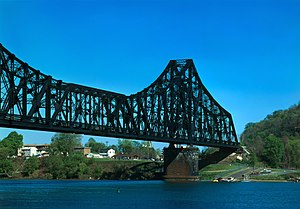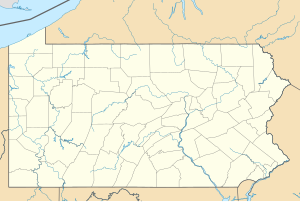Beaver Bridge
Coordinates: 40 ° 41 ′ 35 ″ N , 80 ° 17 ′ 28 ″ W.
| Beaver Bridge | ||
|---|---|---|
| Cantilever part of the bridge, view towards Monaca | ||
| use | Railroad ( CSX ) | |
| Crossing of | Ohio River | |
| place | Beaver , Monaca | |
| construction | Cantilever bridge | |
| overall length | 544.7 meters | |
| Longest span | 234.4 meters | |
| start of building | March 1908 | |
| completion | May 1910 | |
| planner | Albert Lucius | |
| location | ||
|
|
||
The Beaver Bridge is a railroad bridge over the Ohio River in Beaver County , Pennsylvania . The 544.7 meter long structure consists of a cantilever bridge and a short Parker girder . It leads the Pittsburgh Subdivision of the CSX between the cities of Beaver and Monaca across the river.
history
The crossing of the Ohio was one of the greatest challenges of the Pittsburgh and Lake Erie Railroad (P&LE), which from 1875 built a railway line from Pittsburgh to Youngstown . The first, wrought-iron bridge was single-track and opened in 1878. From 1890 the railway line was expanded to two tracks and a new bridge was built on the existing pillars. But these were too narrow for two separate tracks and so they were laid in the form of a track loop. As the traffic continued to increase, the line was expanded to four tracks and it was decided to build a new bridge almost 100 meters upstream.
According to the requirements of the US Department of War , the new bridge had to provide at least a 700- foot (213-meter) wide fairway in the Ohio River, which was beyond the capabilities of ordinary truss bridges . Therefore, a steel cantilever bridge with a maximum span of 234 m was chosen as the main design. The total length of this part of the bridge is 429.5 m. On the north bank, the jib is followed by a short timber frame with a length of 112.8 m in Parker / Camelback construction.
The plans for the new bridge were published in July 1907. At the end of August, the Quebec Bridge collapsed in Canada , which, like the Beaver Bridge, was planned as a cantilever bridge, albeit a much larger one. However, the railway company P&LE stuck to the existing drafts. The German-born engineer Albert Lucius had drafted the preliminary construction plan and attached importance to a comparatively simple, proven and easy-to-calculate construction. Paul L. Wolfel , chief engineer of the executing company McClintic-Marshall Construction Co. from Pittsburgh, added to the plans, which were checked again by Lucius.
The construction work began in March 1908 and ended in May 1910. Despite the rather conservative design, thirteen articles appeared in the specialist journal “Engineering Record” on innovations ranging from unreinforced concrete caissons for the bridge piers to a new type of construction site crane .
After the railway line was dismantled, the Beaver Bridge is now double-tracked. The bridge has been owned by CSX Transportation since 1991 . It is also listed on the Historic American Engineering Record .
Web links
- Monaca-Beaver Railroad Bridge on historicbridges.org (English)
- Historic American Engineering Record: HAER No. PA-501 (English; PDF; 135 kB)



